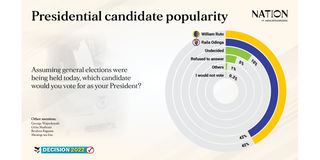Premium
Three battlegrounds for Raila Odinga and William Ruto
Three key battlegrounds that might determine who between DP Wiliam Ruto and ODM leader Raila Odinga becomes the fifth President of Kenya also have the highest rates of undecided voters.
The Nation Media Group opinion poll on the question of preferred presidential candidates has the Lower Eastern region recording 15 per cent undecided voters, followed by the Coast with 13 per cent and Western Kenya 12 per cent.
Nearly 1.7 million votes in Lower Eastern, 2 million at the Coast and 2.6 million in Western should provide significant pickings for any presidential candidate who manages to make inroads into the three regions that are closely contested, raising a lot of questions on voter allegiances.

Along with Nairobi County and Mt Kenya, those are most significant voting blocs where major shifts in projected votes will decide the outcome of the presidential race.
Lower Eastern, which is the Ukambani sub-region of the former Eastern Province, Western and the Coast, are described as battlegrounds because of the shifting dynamics since the last elections have made voter preferences uncertain.
The three regions voted solidly for the Nasa pair of Mr Odinga and his running mate Kalonzo Musyoka in 2017 against the Jubilee Party pairing of President Uhuru Kenyatta and Deputy President Ruto.
Mr Odinga is now the Azimio-One Kenya coalition flagbearer with support of the outgoing president, while Dr Ruto has walked out of the ruling Jubilee party to run on a UDA ticket as the head of the Kenya Kwanza Alliance. The ‘‘Nation’’ poll conducted on May 8 and 9 shows that Mr Ruto has made significant inroads in the three regions, where uncertainties over party and coalition allegiances still leaves lots of room for significant shifts in voter preferences.
The DP is holding onto his Rift Valley strongholds, but significantly has also retained solid support in President Kenyatta’s populous Mt Kenya bloc even after quitting Jubilee. The region is expected to vote solidly for Mr Ruto, but the Odinga campaign team is hoping that support from the president will result in significant inroads, even if just between 20 and 30 per cent of the vote.
Nairobi is another region that can be classified as a battleground for the simple reason that over the past three elections, Mr Odinga has just taken it with narrow margins that could be eroded with just some small shifts.
In the 2017 election, Mr Odinga dominated Lower Eastern with 83 per cent of the vote to President Kenyatta’s 15 per cent. The “Nation” poll now has Mr Odinga with 53 per cent and Ruto at 27 per cent, a significant decline for the former and gain for the latter.
With 15 per cent undecided and a further 5 per cent not responding, there should be rich pickings for whoever of the two main candidates will be more persuasive in the coming months, with the 1.69 million registered voters in Kitui, Machakos and Makueni counties.
A lot might lie in resolution of the impasse in Azimio, where the presumed Lower Eastern political kingpin Mr Musyoka is threatening to bolt out and possibly even re-launch his independent presidential bid if he does not get the nod to be Mr Odinga’s running mate.
Any dilution of Mr Odinga’s 2017 Lower Eastern numbers would be very damaging to his presidential bid and a big bonus for Dr Ruto, who is already celebrating winning over one of his harshest critics, Machakos Governor Alfred Mutua, who crossed over from Azimio last week.
Western Kenya is just as interesting as Lower Eastern. Some 2.5 million votes are up for grabs in a region where Mr Odinga dominated with over 80 per cent of the vote to President Kenyatta’s 17 per cent. The five westerncounties of Kakamega, Vihiga, Busia, Bungoma and Busia, together with the adjacent Trans Nzoia, can easily shift either way depending on local and national dynamics.
The “Nation” poll gives Mr Odinga 48 per cent in western, a significant decline from his 2017 tally, and the beneficiary is Dr Ruto with 33 per cent, a big improvement from the Jubilee ticket at the last elections.
The Deputy President scooped big by securing the support of regional political kingpins, Musalia Mudavadi of ANC and Moses Wetangula of Ford Kenya, who had backed the Odinga campaign last time.
Mr Mudavadi may have disappointed supporters when he dropped his presidential bid to support Dr Ruto, and more so when he was not even rewarded with the running mate slot. It has now emerged, however, that he cut a sweetheart deal that should see him named equivalent of a prime minister, even more powerful than DP, if Kenya Kwanza forms the government.
He and Wetangula will also get to fill 30 per cent of cabinet and other senior government positions from their respective political groupings and ethnic blocs.
There is, however, a catch: The deal is only valid if the two deliver 70 per cent of the western Kenya vote to Dr Ruto, a tall order under any circumstances if the Nation poll and other surveys around the same period are anything to go by.
Then there is Nairobi, a cosmopolitan, ethnic melting pot with a dominant central Kenya voting bloc but with enough communities from other regions to always give Mr Odinga a slight edge. In 2017, Mr Odinga got 51 per cent to President Kenyatta’s 49 per cent. The new “Nation” poll has Mr Odinga retaining his 51 percent but Mr Ruto dropping significantly to 33 per cent. Some 9 per cent of voters are undecided, 5 per cent refused to answer and one per cent each preferred others or would not vote.
Tomorrow: Which is the more popular Coalition, between Azimio One Kenya and Kenya Kwanza Alliance? How about between ODM and UDA parties.





